Published on: April 8, 2025
8 min read
SAFe without silos in GitLab
Learn how to map the Scaled Agile Framework to the native capabilities of the DevSecOps platform and the advantages that come from doing so.

Let's talk about what happens when your organization adopts the Scaled Agile Framework (SAFe) to scale to enterprise levels. You've got multiple teams working on complex products, and you need a way to coordinate all that work. But here's a common headache: Your planning happens in one tool, while your actual development work lives somewhere else entirely.
This divide creates real problems day-to-day. Developers jump between systems constantly. Product managers struggle to get an accurate picture of progress. And everyone wastes time manually copying information from one place to another. It's precisely the kind of disjointed experience that SAFe was designed to eliminate.
While your development teams might already be using GitLab for source code management, CI/CD, and security, you may wonder whether GitLab can also support your planning needs within the SAFe framework. The good news is that GitLab's Agile project management capabilities offer strong support for SAFe, in this article, you'll learn how GitLab maps to SAFe concepts and ceremonies, all within the same DevSecOps platform your software developers already know and love.
What is SAFe?
SAFe, or the Scaled Agile Framework, is a way to bring Agile principles to large organizations without losing speed, alignment, or customer focus. It takes the iterative and flexible teamwork model of small teams and applies its principles across big organizations that have multiple teams, roadmaps, and stakeholders. This brings the organization into alignment, all planning and executing in the same direction. For product managers, SAFe helps connect strategy to execution so you’re not just shipping fast, you’re shipping the right things, backed by clear priorities and cross-team alignment.
SAFe reduces silos, encourages collaboration, and helps teams rally around customer outcomes, not just tasks. When integrated in GitLab, the magic really happens: visibility, traceability, and delivery all live in one place.
SAFe terminology in GitLab
First, let's establish how SAFe concepts map to GitLab:
| SAFe | GitLab |
|---|---|
| Epic | Top-level Epic |
| Capability | Sub-epic (Level 1) |
| Feature | Sub-epic (Level 2) |
| User Story | Issue |
| Task | Task |
| Team | Custom Field / Scoped Label |
| Sprint | Iteration |
| Program Increment (PI) | Milestone |
| Value Stream | Top-level Group |
| Agile Release Train (ART) | Top-level Group |
With this mapping as your guide, you can set up GitLab to mirror your SAFe implementation. The group structure lets you organize around your value streams and ARTs, while the work item hierarchy (with up to seven levels of nested epics!) gives you all the depth you need for complex product portfolios. Whether you're working at the portfolio level (with top-level groups), program level (with subgroups), or team level (with projects), GitLab's organizational structure aligns perfectly with SAFe's hierarchy.
Supporting SAFe ceremonies in GitLab
Now for the fun part - how do you actually run your SAFe ceremonies in GitLab? Let's walk through each one.
PI planning
To facilitate the cross-team alignment and dependency management that makes PI planning successful, GitLab offers several capabilities:
- Use the Roadmap view to visualize features across teams and time periods
- Assign features to the PI milestone
- Document and visualize cross-team dependencies as they're identified
GitLab gives you flexibility for PI planning through both the Epic boards (which can be configured to show team assignments) and the Roadmap view (which shows features over time like a Gantt chart). You can switch between these views during your planning session depending on whether you're focusing on the timeline or team organization.
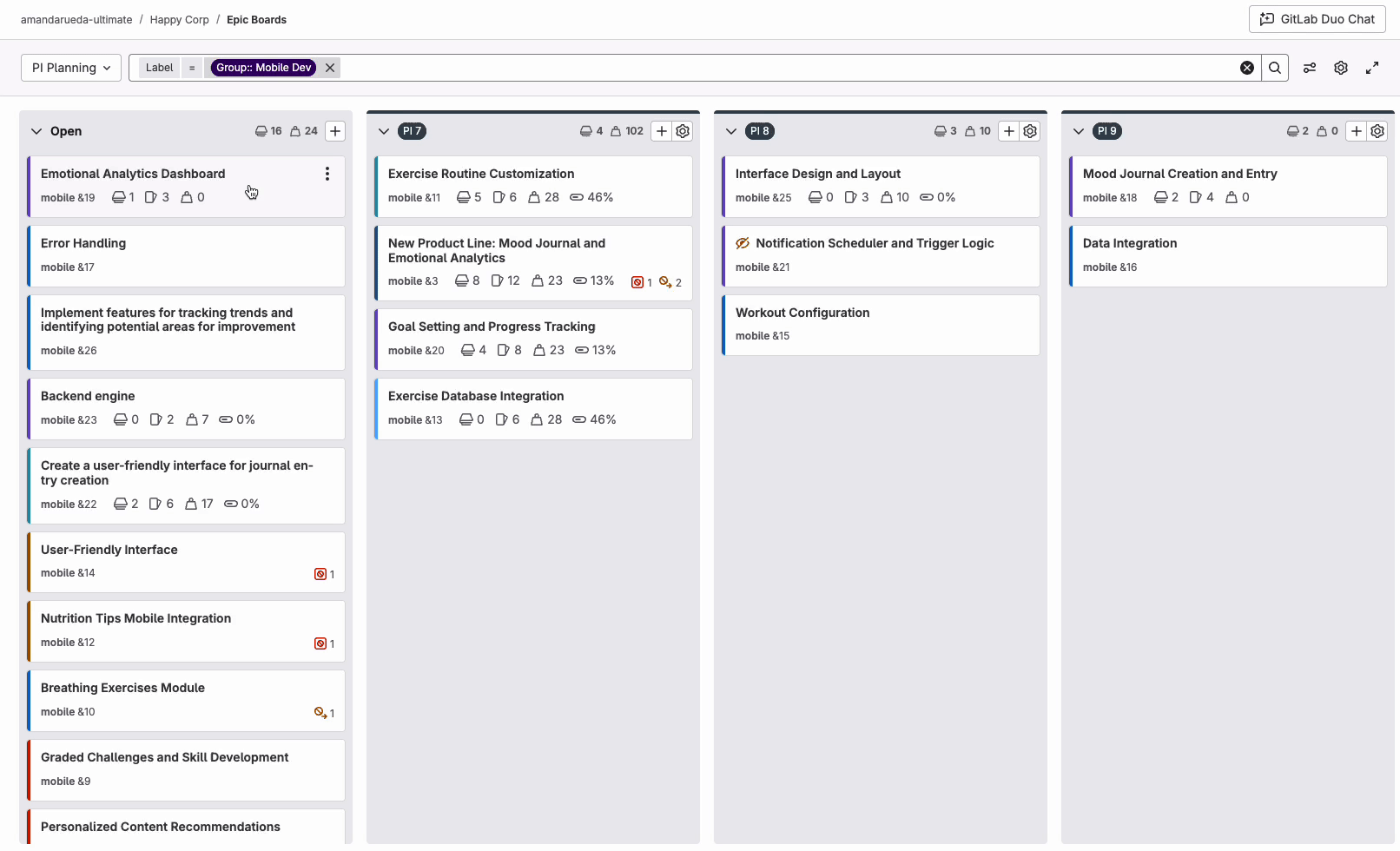
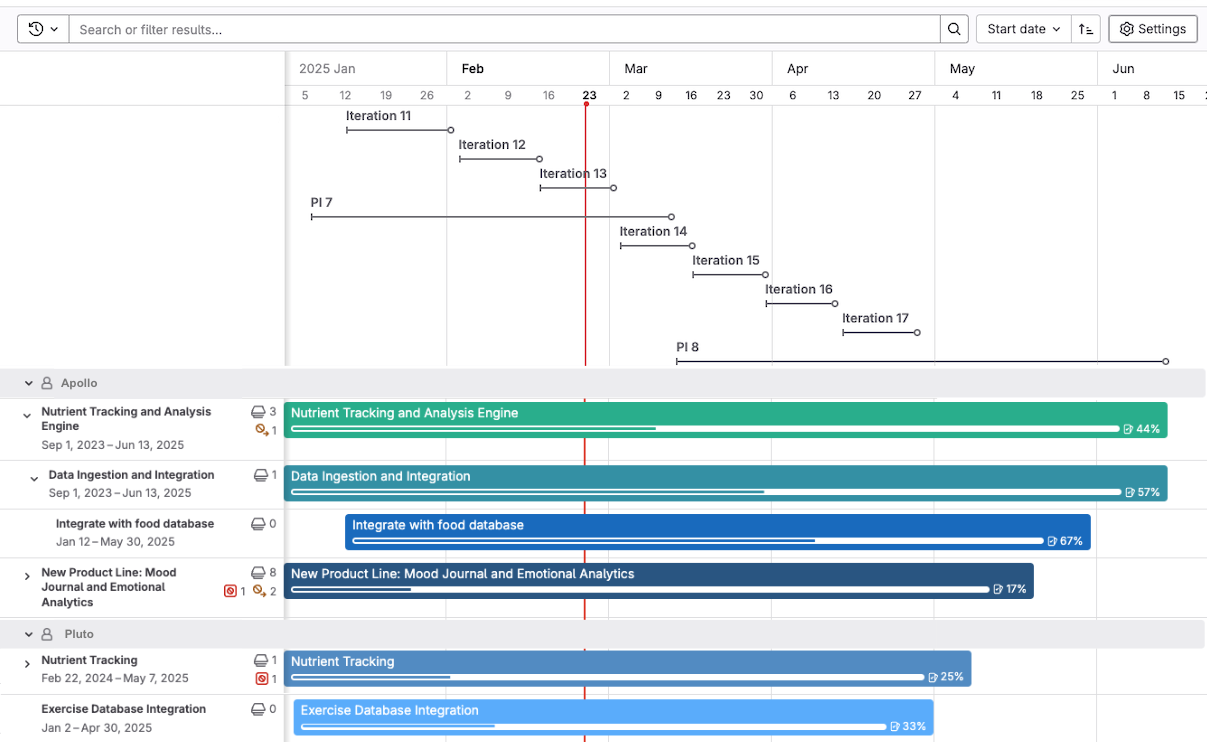
Refinement
As a product manager, running effective refinement sessions means having clear visibility into your feature backlog. You can run your refinement session right inside GitLab. No more updating one tool during the meeting and then having to update another tool afterward.
GitLab powers refinement sessions with:
- Epic boards that group features based on status
- The ability to view story points directly in the overview
- Comprehensive drawer views that let you interact with work items without losing context
- The ability to create and link child issues directly from epics
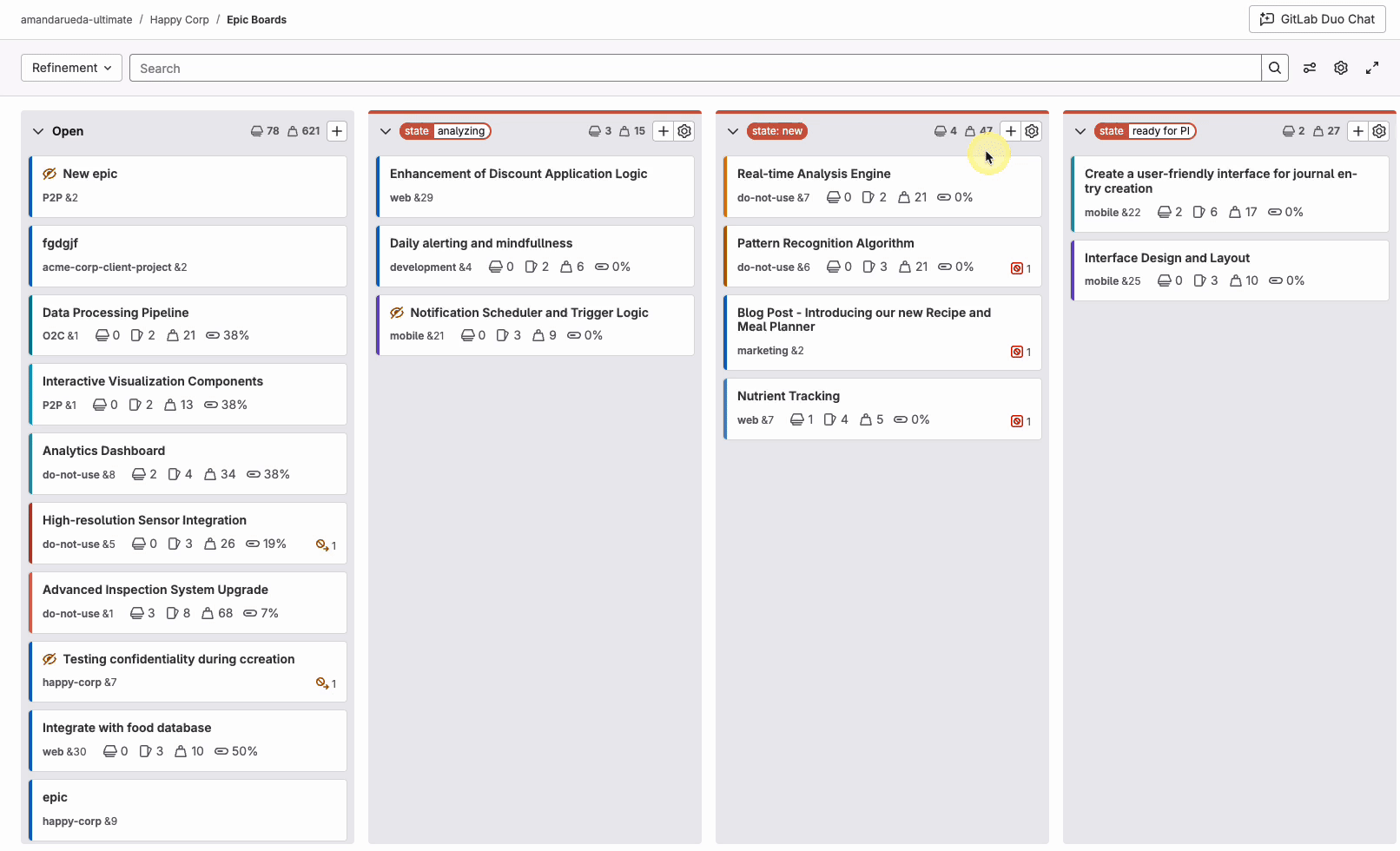
Sprint planning
When it's time to figure out what your team can tackle in the next sprint, GitLab gives you:
- Issue boards that provide a comprehensive view of your backlog
- Total weight of user stories displayed directly on boards
- The ability to easily move issues between iterations
- A collapsible view that simplifies moving stories between sprints
This means you can keep everything in one place and spend your planning meetings actually planning instead of jumping between tools.
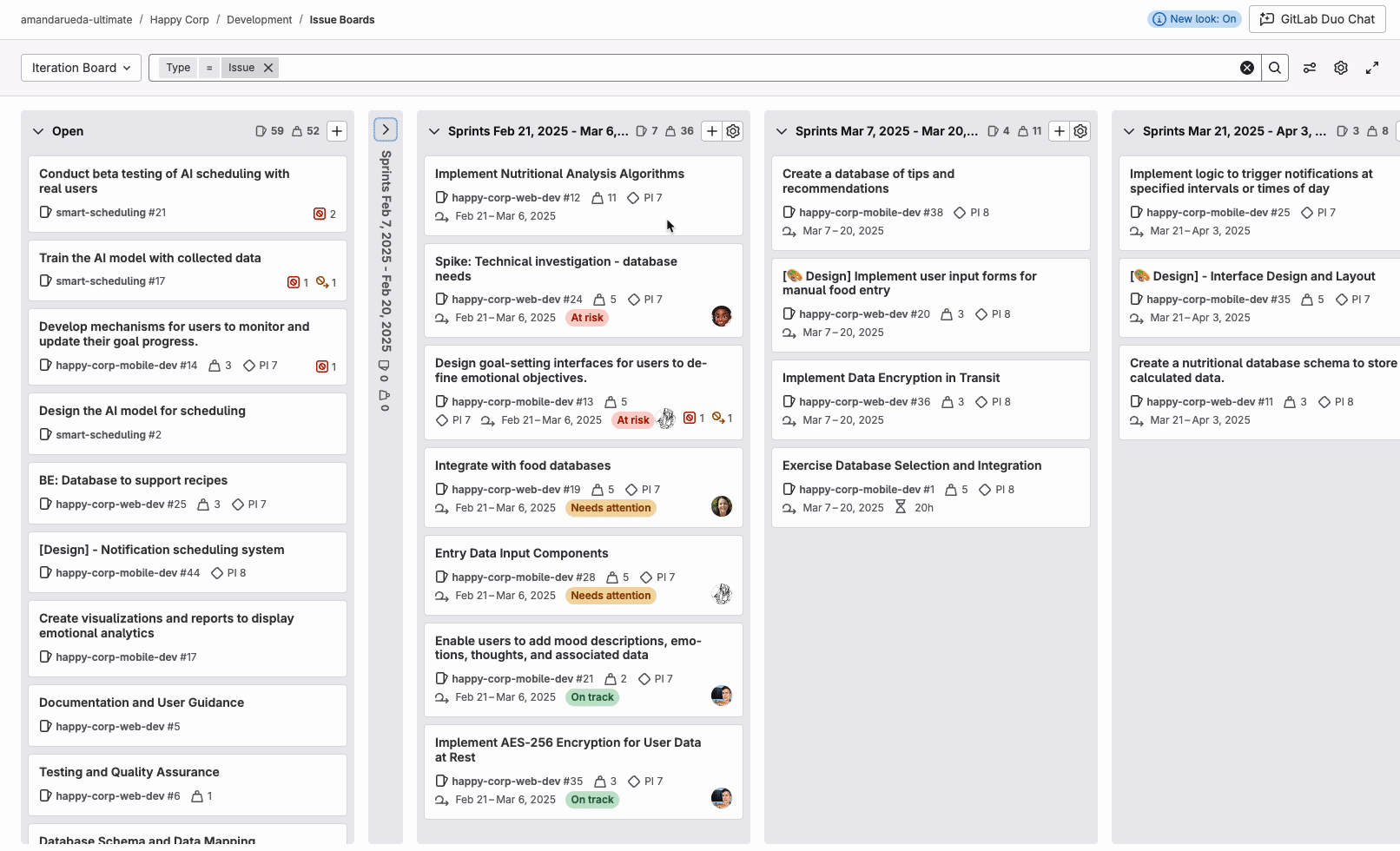
💡 Check out this tutorial on using GitLab to facilitate Scrum for a detailed glimpse into the power of GitLab in Agile planning and sprint tracking.
Daily stand-ups
Your team can gather around the board during daily stand-ups and actually see what everyone's working on, what's stuck, and what's ready for review – all in one view. For your dev team's daily stand-ups, GitLab lets you:
- Create iteration-scoped boards that show the current sprint's work
- Display story points/weights directly on cards
- Use the drawer view to access details without leaving the context
- Highlight tasks at risk through health status
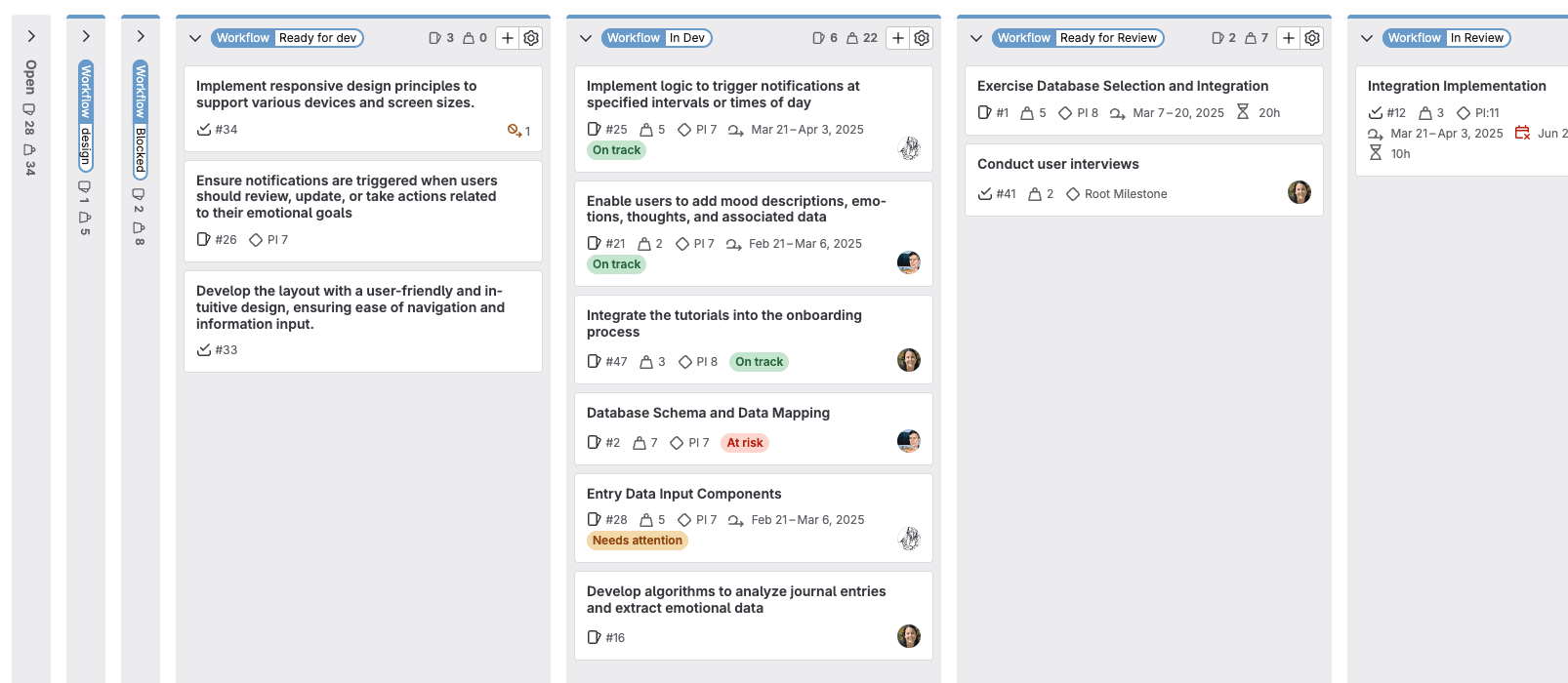
Sprint review
Want to know how your team is doing over time? GitLab provides comprehensive metrics with:
- Burndown and burnup charts for iterations
- Velocity tracking
- Lead and cycle time metrics
- Dashboards that can be scoped to teams
These metrics help you understand if your team is getting faster, where they're getting stuck, and what you might want to talk about in your next retrospective.
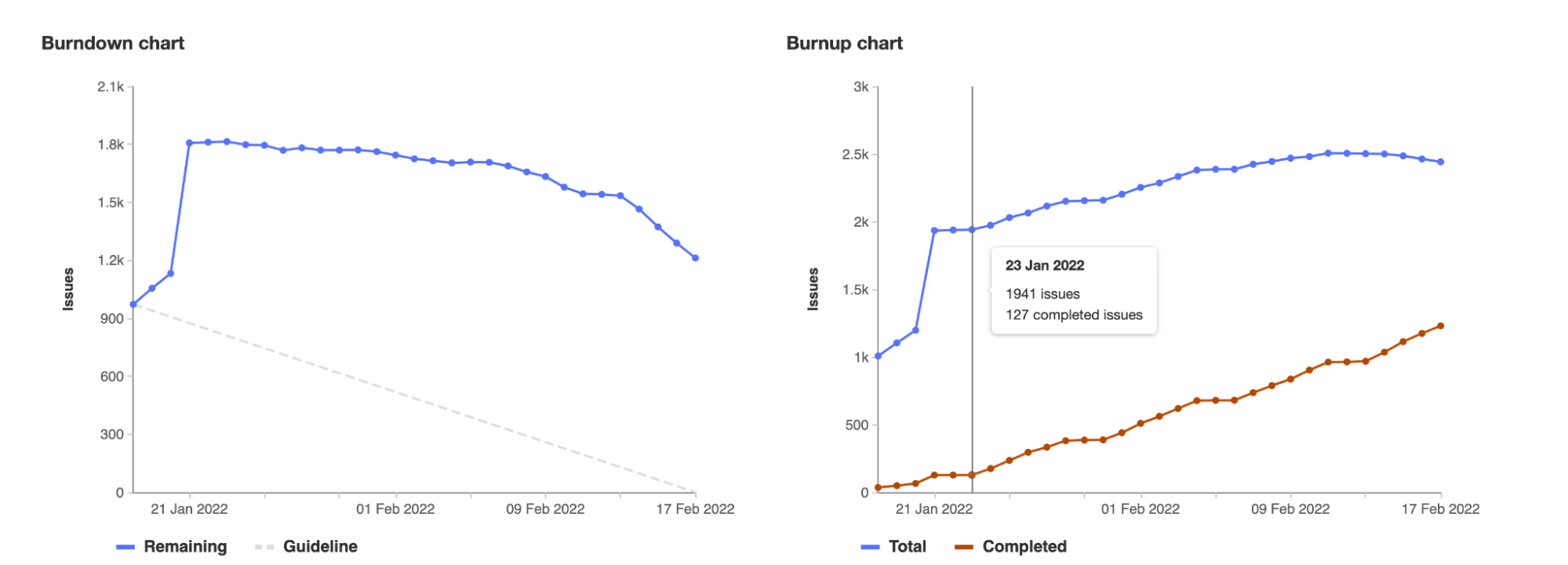
5 reasons a unified platform provides an advantage
I know there are plenty of planning tools that can handle SAFe ceremonies. But there are game-changing reasons why I genuinely believe GitLab is different:
- No more context switching - Your planning, coding, testing, and security all happen in one place.
- Everything's connected - You can trace work from the big epic down to the code and deployment.
- Everyone's on the same page - Developers, product folks, and security teams all work together in the same tool.
- Total visibility - Stakeholders have one place to check for updates.
- The full picture - You see planning and development metrics together, so you know what's really going on.
If your dev teams already love GitLab, why make them jump to another tool for planning or create some complex, cobbled-together integrations? Bringing your SAFe planning into GitLab creates a much smoother experience for everyone.
Implementation principles
I've worked with teams transitioning from traditional SAFe tools to GitLab, and here's what I've learned: Focus on what each ceremony is trying to accomplish, not on recreating exact replicas of your old tools.
The teams that get the most out of GitLab are the ones who embrace its native capabilities instead of fighting against them. Yes, it takes some initial work to figure out how to map your SAFe concepts and set up your workflows. But once you do, you'll find your processes actually get simpler rather than more complex.
The key is defining conventions that everyone follows. Which labels mean what? How will you track teams? What goes in an epic versus an issue? With a little upfront investment in these decisions, you'll end up with an intuitive system that eliminates all that cross-tool coordination overhead.
Getting started
Ready to give this a shot? Here's how to start implementing SAFe in GitLab:
- Set up your structure - Create groups and subgroups that match your organization.
- Define your work breakdown - Decide how you'll use epics, issues, and tasks.
- Create your iterations - Set up your sprint schedule.
- Add your milestones - Milestones will represent your Program Increments in GitLab.
- Build your boards - Create different views for different ceremonies.
- Agree on conventions - Document how you'll use labels and custom fields.
Taking time to think through these decisions upfront will save you many headaches later. And remember, you don't have to perfect it on day one - you can always adjust as you learn.
Bringing it all together
GitLab gives you a solid foundation for running SAFe, especially if your dev teams are already GitLab fans. When you bring planning and development into the same tool, you eliminate those painful handoffs, make collaboration way easier, and get everything moving faster.
The beauty of GitLab's planning tools is that they're flexible enough to adapt to your specific flavor of SAFe. You're not locked into rigid workflows - you can evolve your approach as your teams mature and your needs change.
Ready to see how much better life is without those planning silos? Start your free trial today and experience firsthand how GitLab can transform your SAFe implementation.
💡 If you liked this topic check out this related post - GitLab for Agile Software Development
